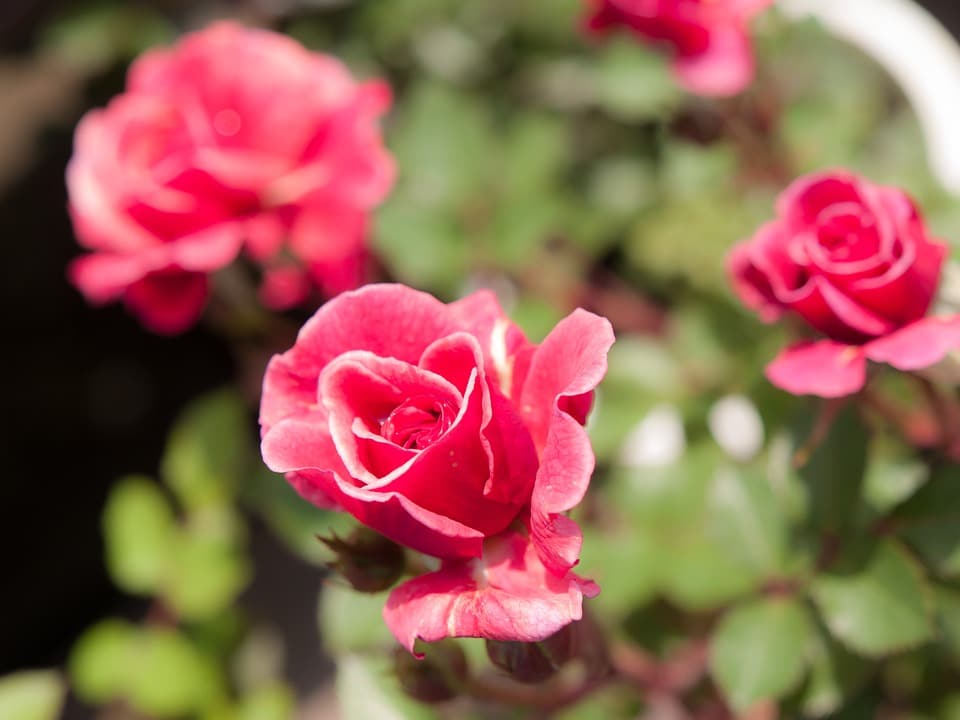
Rose lovers short on space need not give up growing these beauties. Instead, try miniature roses. These dainty plants have all the qualities of their larger siblings, but on a smaller scale. They’re also easy to grow and hardy, and their dwarf habit makes them versatile enough for not only in-ground growing, but containers as well; some varieties are even scented, too.
Despite their name, miniatures can grow from four inches (10 cm) to six or even eight feet (1.8 – 2.4 m) though most miniatures average 18 to 30 inches (45-76 cm) in height. They’re sometimes classified as micro-minis, medium miniatures, larger-sized miniatures and climbers (also called patio climbers).
Whether you’re growing miniatures in pots or in the ground, roses do best with a minimum of four hours of sun daily, and well-aerated, moisture-retentive soil. I add several handfuls of compost or perlite to my rose soil. To encourage repeat blooming, deadhead regularly. For pot culture, make sure the container you choose has drainage holes and is large enough for the full-sized plant (roses hate having their roots disturbed). Climbing miniatures require half-barrel-sized pots; all others need pots that hold at least 1.7 gallons (8 L).
Watering
Watering requirements depend on temperature, hours of sunlight, wind and soil type, but here is the general rule for container-grown and in-ground miniatures.
Container: Water potted roses daily (or every other day) at the height of summer until water comes out the drainage holes.
In ground: Water when the first two inches (5 cm) of soil dries out. Watering deeply slightly less often is preferable to more frequent, shallow watering.
Fertilizing
Fertilize miniature roses in spring when all winter protection is removed.
Container: Potted plants respond well to a balanced slow-release fertilizer (follow package directions) or a weekly dose of fish fertilizer.
In-ground: Feed garden plants a mild dose of fish fertilizer every couple of weeks and augment with a light top dressing of granular rose food monthly.
Overwintering
Their delicate appearance aside, miniature roses can withstand light freezing, but like winter protection once the temperature gets to -10°C for more than a week.
Container: Move potted miniatures into an unheated garage or cold basement for the winter. “It doesn’t need to be light, but it shouldn’t be completely dark either,” says David Wilson, owner of The Heather Farm & Classic Miniature Roses in Sardis, B.C. “Wrap the pot in fabric or a blanket and water the plants a few times during the winter. They should stay on the drier side, but the soil shouldn’t completely dry out and harden either.”
In-ground: Miniature rose in the garden can be treated one of two ways. Wilson says you can prune the plant back by one-third or a little more in the fall before mounding four to six inches (10 to 15 cm) of soil around the rose base followed by a lighter material like sawdust or leaf mulch until the plant is completely covered. This allows in moisture and enables air to circulate during the winter. Wilson also says he knows gardeners who dig up the entire rose plant, lay it in a trench, cover it with soil and bury it for the winter.
Minimizing miniature rose problems
Mildew and blackspot can sometimes be a problem for miniature roses.
- To avoid mildew, provide good air circulation and avoid watering during humid weather.
- To discourage blackspot, consider applying a fungicide during warm, humid weather (ideal blackspot conditions); if the plant is afflicted, remove infected stems and leaves from both the plant and surrounding soil immediately. Do not compost.
- Aphids love rose foliage. I squish small colonies by hand and spray larger infestations with a mild dish soap solution (not on sunny days).
Did you know?
Miniature roses were popular in Europe in the 1800s when cultivars of Rosa chinensis ‘Minima’ were widely available. But their popularity decreased until the discovery of a single pink China rose in a Swiss window box in the 1930s, says David Wilson. That rose, called ‘Rouletti’, is believed to be a variant of ‘Minima’ and gave rise to the miniatures we grow today.
A few favourites
The following roses are all favourites for different reasons. Some get my vote for strong scent (Scentsational and Corinne’s Choice) or unusual color (Sandalwood and Rainbow’s End) while others are my pick for perfect form (Mountie) or reliability (‘Jeanne Lajoie’). Sizes given are for in ground plants. Container grown plants may be smaller depending on the size of the pot.
‘Jeanne Lajoie’: Reliable, disease-resistant climber with scented double-pink blooms. Height: 6 to 8 feet or more (1.8 to 2.4 m) in the ground, considerably shorter in pots. My container grown specimen grows about three feet (91 cm), is shrub-like and doesn’t need staking.
Sandalwood: Striking terracotta blooms with a spicy scent. Temperamental, but the gorgeous flowers are worth it. Height: 12 to 14 inches (30 to 35 cm).
Corinne’s Choice: Pure white blooms with a lovely scent; disease resistant. Height: 18 to 24 inches (45 to 60 cm).
Rainbow’s End: Striking blooms that are deep yellow, blushing to orange-red, unscented; prone to blackspot but shade tolerant and prolific. Height: 12 to 21.5 inches (30 to 55 cm).
Scentsational: Large lavender-pink blooms with a strong scent. Height: 24 to 30 inches (60 to 75 cm).
Mountie: Double red blooms with very slight fragrance; high disease resistance; Ontario-bred. Height: 12 to 20 inches (30 to 50 cm).









I adore miniature roses. Thank you for the article and the link to Heather Farm. Yum Yum!
The only concern I’d have about that, Ethel, is that too many roses together in a planter might encourage mildew, something that plagues many miniature roses. But if your planter is large and the plants have enough air circulation, it’s certainly worth a try.
better to plant lots of plants in a planter than just a few?